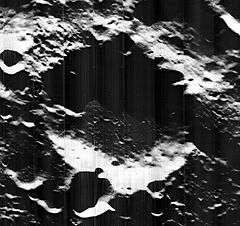Hippocrates (lunar crater)
Hippocrates is a lunar impact crater on the far side of the Moon. It is located in the northern region of the lunar surface, to the north of the crater Stebbins. To the southwest of Hippocrates are Kirkwood and the large Sommerfeld.
 Clementine mosaic | |
| Coordinates | 70.7°N 145.9°W |
|---|---|
| Diameter | 60 km |
| Depth | Unknown |
| Colongitude | 148° at sunrise |
| Eponym | Hippocrates |

This is a relatively old formation that has become worn and eroded due to subsequent impacts. The general outline of the outer rim is still visible, but it is overlaid along the eastern edge by a smaller crater. There is also a small craterlet along the western edge. The inner wall is marked by a number of tiny craterlets, and is slightly wider at the southern edge with a ridge-like projection. The interior floor is level and almost featureless, with only a few tiny craterlets to mark the surface.
This crater was named after Hippocrates, the ancient Greek physician.
Satellite craters
By convention these features are identified on lunar maps by placing the letter on the side of the crater midpoint that is closest to Hippocrates.
| Hippocrates | Latitude | Longitude | Diameter |
|---|---|---|---|
| Q | 69.0° N | 148.0° W | 35 km |
References
- Andersson, L. E.; Whitaker, E. A. (1982). NASA Catalogue of Lunar Nomenclature. NASA RP-1097.CS1 maint: ref=harv (link)
- Blue, Jennifer (July 25, 2007). "Gazetteer of Planetary Nomenclature". USGS. Retrieved 2007-08-05.CS1 maint: ref=harv (link)
- Bussey, B.; Spudis, P. (2004). The Clementine Atlas of the Moon. New York: Cambridge University Press. ISBN 978-0-521-81528-4.CS1 maint: ref=harv (link)
- Cocks, Elijah E.; Cocks, Josiah C. (1995). Who's Who on the Moon: A Biographical Dictionary of Lunar Nomenclature. Tudor Publishers. ISBN 978-0-936389-27-1.CS1 maint: ref=harv (link)
- McDowell, Jonathan (July 15, 2007). "Lunar Nomenclature". Jonathan's Space Report. Retrieved 2007-10-24.CS1 maint: ref=harv (link)
- Menzel, D. H.; Minnaert, M.; Levin, B.; Dollfus, A.; Bell, B. (1971). "Report on Lunar Nomenclature by the Working Group of Commission 17 of the IAU". Space Science Reviews. 12 (2): 136–186. Bibcode:1971SSRv...12..136M. doi:10.1007/BF00171763.CS1 maint: ref=harv (link)
- Moore, Patrick (2001). On the Moon. Sterling Publishing Co. ISBN 978-0-304-35469-6.CS1 maint: ref=harv (link)
- Price, Fred W. (1988). The Moon Observer's Handbook. Cambridge University Press. ISBN 978-0-521-33500-3.CS1 maint: ref=harv (link)
- Rükl, Antonín (1990). Atlas of the Moon. Kalmbach Books. ISBN 978-0-913135-17-4.CS1 maint: ref=harv (link)
- Webb, Rev. T. W. (1962). Celestial Objects for Common Telescopes (6th revised ed.). Dover. ISBN 978-0-486-20917-3.CS1 maint: ref=harv (link)
- Whitaker, Ewen A. (1999). Mapping and Naming the Moon. Cambridge University Press. ISBN 978-0-521-62248-6.CS1 maint: ref=harv (link)
- Wlasuk, Peter T. (2000). Observing the Moon. Springer. ISBN 978-1-85233-193-1.CS1 maint: ref=harv (link)